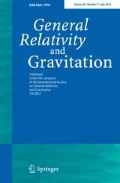Abstract
The only nontrivial exact solutions reported to-date for the field equations of the null-surface formulation (NSF) of general relativity are for the (\(2+1\))-dimensional version of the theory, where three such solutions are known. This work presents a new family of NSF solutions. The corresponding general relativistic spacetimes are shown to span three different Petrov types, depending upon the choices that are made for various parameters. All of the scalar invariants for the spacetimes are constant, as are all of the eigenvalues of the Cotton-York tensor. The physical nature of a possible source term is discussed in detail, and two of the previously known NSF solutions are presented as special cases. The new family of solutions was derived by assuming additive separability—meaning that the dependent variable in the field equations is represented as a sum. This effectively turns the main NSF field equation (which is a partial differential equation) into an ordinary differential equation that is exactly solvable. The possibility of adapting this approach to the (\(3+1\))-dimensional version of the NSF is discussed.
Similar content being viewed by others
Data Availability Statement
Not applicable to this article as no datasets were generated or analyzed during the current study.
References
Kozameh, C.N., Newman, E.T.: J. Math. Phys. 24, 2481 (1983)
Frittelli, S., Kozameh, C.N., Newman, E.T.: J. Math. Phys. 36, 4975 (1995)
Frittelli, S., Kozameh, C.N., Newman, E.T.: J. Math. Phys. 36, 4984 (1995)
Frittelli, S., Kozameh, C.N., Newman, E.T.: J. Math. Phys. 36, 5005 (1995)
Frittelli, S., Kozameh, C.N., Newman, E.T.: J. Math. Phys. 36, 6397 (1995)
Gallo, E.: Class. Quantum Gravit. 29, 145004 (2012)
Forni, D.M., Iriondo, M., Kozameh, C.N.: J. Math. Phys. 41, 5517 (2000)
Forni, D.M., Iriondo, M., Kozameh, C.N., Parisi, M.F.: J. Math. Phys. 43, 1584 (2002)
Tanimoto, M.: On the Null Surface Formalism—Formulation in Three Dimensions and Gauge Freedom. arXiv:gr-qc/9703003 (1997)
Silva-Ortigoza, G.: Gen. Relativ. Gravit. 32, 2243 (2000)
Cartan, E.: C. R. Acad. Sci. 206, 1425 (1938)
Cartan, E.: Rev. Mat. Hispano-Amer. 4, 1 (1941)
Cartan, E.: Ann. Sc. Ec. Norm. Sup. (3) 60, 1 (1943)
Chern, S.-S.: The Geometry of the differential equation \(y^{\prime \prime \prime } = F(x, y, y^{\prime }, y^{\prime \prime })\). In: Selected Papers. Springer, New York (1978). Original version: Science Reports Nat. Tsing Hua Univ. 4, 97 (1940)
Harriott, T.A., Williams, J.G.: Gen. Relativ. Gravit. 46, 1666 (2014)
Harriott, T.A., Williams, J.G.: Solutions in the \(2+1\) null-surface formulation. In: Bicak, J., Ledvinka, T. (eds.) Relativity and Gravitation 100 Years After Einstein in Prague. Springer Proceedings in Physics, vol. 157. Springer, New York (2014)
Harriott, T.A., Williams, J.G.: Gen. Relativ. Gravit. 50, 39 (2018)
Harriott, T.A., Williams, J.G.: Gen. Relativ. Gravit. 51, 98 (2019)
Weinberg, S.: Gravitation and Cosmology. John Wiley, New York (1972)
Chow, D.D.K., Pope, C.N., Sezgin, E.: Class. Quantum Gravit. 27, 105002 (2010)
Podolsky, J., Svarc, R., Maeda, H.: Class. Quantum Gravit. 36, 015009 (2019)
Garcia-Diaz, A.A.: Exact Solutions in Three-Dimensional Gravity. Cambridge University Press, Cambridge (2017)
Madsen, M.S.: Astrophys. Space. Sci. 113, 205 (1985)
Madsen, M.S.: Class. Quantum Gravit. 5, 627 (1988)
Faraoni, V.: Phys. Rev. D 85, 024040 (2012)
Ellis, G.F.R., Maartens, R., MacCallum, M.A.H.: Relativistic Cosmology. Cambridge University Press, Cambridge (2021)
Barrow, J.D., Shaw, D.J., Tsagas, C.G.: Class. Quantum Gravit. 23, 5291 (2006)
MacCallum, M.A.H., Stewart, J.M., Schmidt, B.G.: Commun. Math. Phys. 17, 343 (1970)
Cavaglià, M.: Phys. Rev. D 57, 5295 (1998)
Frittelli, S., Kozameh, C.N., Newman, E.T.: Commun. Math. Phys. 223, 383 (2001)
Frittelli, S., Kozameh, C.N., Newman, E.T., Nurowski, P.: Class. Quantum Gravit. 19, 5235 (2002)
Gallo, E., Marciano-Melchor, M., Silva-Ortigoza, G.: Int. J. Mod. Phys. D 16, 1725 (2007)
Newman, E.T., Penrose, R.: J. Math. Phys. 7, 863 (1966)
Goldberg, J.N., Macfarlane, A.J., Newman, E.T., Rohrlich, F., Sudarshan, E.C.G.: J. Math. Phys. 8, 2155 (1967)
Torres del Castillo, G.F.: 3-D Spinors, Spin-Weighted Functions and their Applications. Birkhauser, Boston (2003)
Bordcoch, M., Kozameh, C.N., Rojas, T.A.: Phys. Rev. D 94, 104051 (2016)
Acknowledgements
The authors would like to thank Dr. Alan Coley for a number of helpful comments. We would also like to acknowledge the generous hospitality of Dr. Ted Newman during our visits to the University of Pittsburgh.
Author information
Authors and Affiliations
Corresponding author
Additional information
Publisher's Note
Springer Nature remains neutral with regard to jurisdictional claims in published maps and institutional affiliations.
Appendix: Christoffel symbols and curvature tensors
Appendix: Christoffel symbols and curvature tensors
The Christoffel symbols are
Using the abbreviation \(W := A + 8a\, y^{-1}\), the Ricci tensor can be written as a matrix, \([R_{ij}]\):
The scalar curvature, R, is given in Eq. (24).
The components of the Einstein tensor, \(G_{ij} = R_{ij} - \frac{1}{2} R g_{ij}\), are
The covariant derivatives of the velocity can be written as a matrix, \([ U_{i \, ; \, j} ]\):
The acceleration vector, \({\dot{U}}_{i}\), is defined by \({\dot{U}}_{i} := U_{i\, ;\, j}\, U^{j}\), and its components are
The components of the heat-flux vector \(q_{i}\) are
The only nonzero components of the vorticity tensor, \(\omega _{ij}\), are
The components of the shear tensor, \(\sigma _{ij}\), are
The components of the Cotton-York tensor, \(C^{i}_{\, j}\), are defined in Eq. (27) and are as follows:
Rights and permissions
About this article
Cite this article
Harriott, T.A., Williams, J.G. Solutions for the null-surface formulation in \(2+1\) dimensions leading to spacetimes of Petrov types I, II, and D. Gen Relativ Gravit 54, 34 (2022). https://doi.org/10.1007/s10714-022-02922-7
Received:
Accepted:
Published:
DOI: https://doi.org/10.1007/s10714-022-02922-7


